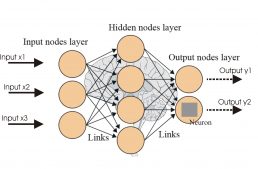Multi-Layer Perceptrons (MLP) and Backpropagation algorithm
Single Layer Perceptron – This is the simplest feedforward neural network and does not contain any hidden layer.
Minsky and Papert mathematically analyzed Perceptron and demonstrated that single-layer networks are not capable of solving problems that are not linearly separable. As they did not believe in the possibility of constructing a training method for networks with more than one layer, they concluded that neural networks would always be susceptible to this limitation.
The multilayer perceptron (MLP) is a neural network similar to perceptron, but with more than one layer of neurons in direct power. Such a network is composed of layers of neurons connected to each other by synapses with weights. Learning in this type of network is usually done through the back-propagation error algorithm, but there are other algorithms for this purpose, such as Rprop.
However, the development of the backpropagation training algorithm has shown that it is possible to efficiently train networks with intermediate layers, resulting in the most used artificial neural networks model currently, Perceptron Multi-Layer (MLP) networks, trained with the backpropagation algorithm.
The backpropagation algorithm was originally introduced in the 1970s, but its importance wasn't fully appreciated until a famous 1986 paper byDavid Rumelhart, Geoffrey Hinton, and Ronald Williams. That paper describes several neural networks where backpropagation works far faster than earlier approaches to learning, making it possible to use neural nets to solve problems which had previously been insoluble. Today, the backpropagation algorithm is the workhorse of learning in neural networks.
Backpropagation is a method used in artificial neural networks to calculate a gradient that is needed in the calculation of the weights to be used in the network.[1] It is commonly used to train deep neural networks,[2] a term referring to neural networks with more than one hidden layer.[3]
Backpropagation is a special case of an older and more general technique called automatic differentiation. In the context of learning, backpropagation is commonly used by the gradient descent optimization algorithm to adjust the weight of neurons by calculating the gradient of the loss function. This technique is also sometimes called backward propagation of errors, because the error is calculated at the output and distributed back through the network layers.
The backpropagation algorithm has been repeatedly rediscovered and is equivalent to automatic differentiation in reverse accumulation mode. Backpropagation requires the derivative of the loss function with respect to the network output to be known, which typically (but not necessarily) means that a desired target value is known. For this reason it is considered to be a supervised learning method, although it is used in some unsupervised networks such as autoencoders. Backpropagation is also a generalization of the delta rule to multi-layered feedforward networks, made possible by using the chain rule to iteratively compute gradients for each layer. It is closely related to the Gauss–Newton algorithm, and is part of continuing research in neural backpropagation. Backpropagation can be used with any gradient-based optimizer, such as L-BFGS or truncated Newton.
Here an example of the code:




Comentários
Postar um comentário